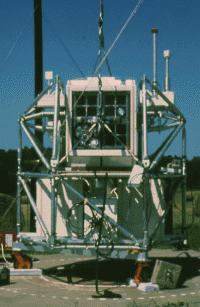 High Energy X-Ray Experiment (HEXE)
High Energy X-Ray Experiment (HEXE)

The High Energy X-Ray Experiment (HEXE) was a balloon-borne instrument to observe X-ray sources built and operated in close collaboration by the Max-Planck-Institut für extraterrestrische Physik and the Institut für Astronomie und Astrophysik der Universität Tübingen, both from Germany. It was the successor of a detector also built and operated by these two institutions with which the famous cyclotron line in the Her X-1 X-Ray source has been discovered.
The instrument consisted of three modules with 12 phoswich detectors of the same type and a cooled pure Germanium solid state spectrometer, mounted in a stabilized and orientable gondola.
It was flown three times, in May 1980 and September 1981 being launched from the National Scientific Balloon Facility base located in Palestine, Texas and in November of 1982 from Uberaba, Brazil.
In 1987, a modified version of the instrument (called Mir-HEXE) was sent to the MIR space station. It was installed in the Kvant module, performing X-Ray observations until the moment of the station's deorbiting in March 2001.
List of flights of the HEXE instrument
| Launch base | Date | Flight Duration | Experiment | Payload landing place or cause of the failure |
|---|---|---|---|---|
 Palestine (TX) Palestine (TX) | 5/9/1980 | 46 h | HEXE (High Energy X-Ray Experiment) | 17 miles E of Seminole, Texas, US |
 Palestine (TX) Palestine (TX) | 9/28/1981 | 22 h | HEXE (High Energy X-Ray Experiment) | 32 miles SW of Dalhart, Texas, US |
 Uberaba (MG) Uberaba (MG) | 11/25/1982 | 4 h | HEXE (High Energy X-Ray Experiment) | Aborted mission due to a hole in the balloon. Payload recovered undamaged. |

